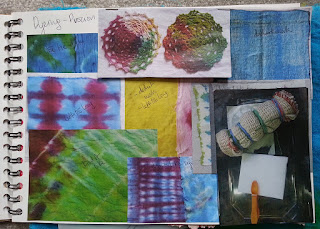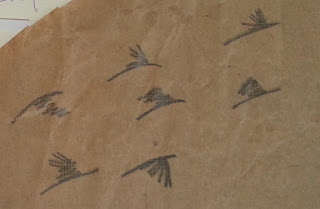As an aspiring artist at the beginning of my journey I have a forensic fascination with how established artist got to be where they are. So an initial flick through my review copy of 3D Mixed Media Textile Art by Textileartist.org shows headings that really resonate with me.
First, a table of contents that lists a superb cohort of textile artists such as Sian Martin, Gizella K Warburton and Karen Nicol. But most importantly each chapter is divided into:
- 'Beginnings'
- 'Inspiration'
- 'Process and Practice'
Those are exactly the questions I want to hear answers for from artists I admire.
Beginnings
Right now what I don't want is thematic essays on art perspectives I didn't even know existed. I want the nuts and bolts of how and why. I also want to be seduced by stories of running away to Paris after art school in the 60s and making a spectacular career as Karen Nicol did.
 |
| Jean Draper detail of Aftermath from 3d mixed media textile art © Textileartist.org |
I was amused by Jean Draper's beginnings because they are diametrically opposed to mine.
"A lack of aptitude in Latin... meant that Jean was demoted to the B stream. What might have originally been perceived as a knock was actually a blessing, as it enabled her to take Needlework as a GCE subject and so influenced a lifetime's work."At my school Latin was pitched against Needlework when the time came to choose, and I not only had a natural aptitude for foreign languages (alive or dead) but was assured by well-meaning parents that "I could draw any time." And so was influenced into a lifetime of office work!
Inspiration
Hearing about artists' inspirations validates themes I might be interested in pursuing. Landscape, architecture, birds, memory. It makes it OK to be interested in minute subjects. This is where the artist communicates.
I have some themes that keep coming to stay: what happens to people's stories after they die. My father recently passed away. What will happen to his stories? Like the time he shook hands with Emperor Haile Selassie or escaped an African revolution in the clothes he was wearing. What will happen to my stories?
This is also the scary part isn't it? The part where you give of yourself. Jean Draper is haunted by a devastating wildfire. Faig draws inspiration from society and tradition in his rugs.
 |
| Faig Ahmed details of Tradition in Pixel and Flood of yellow weight from 3D mixed media textile art © Textileartist.org |
Some inspirations, though, I can't say I understand. Like June Lee's intrigue with "the idea of prejudice and the difference in values and standards between oneself and..." I just trail off at those inspirations. They sound too much like that Art Statement Generator. Plus I don't see how her work actually embodies her statement. I feel alienated. Silk heads, do I like them? Could I do it? No and no. But I understand that this is what June Lee needs to do to communicate something from inside herself.
 |
| June Lee detail of Bystander from 3D mixed media textile art © Textileartist.org |
Faig's take on Persian carpets is of particular interest to me as I grew up in the Far East and the homes I've lived in have been full of these kinds of carpets. Or rather, not these kinds at all, Faig's rugs are humorous and poignant.
One of the most interesting parts of revealing artist's inspirations is when they speak about other artists or people that have influenced them. It has widened my world to new people like Magdalena Abakanowicz or Mark Newport.
Process & Practice
Because I'm unashamedly at the imitation stage of my journey, finding my feet, it's really helpful to have blow-by-blow explanations of how work is actually done. I like to know whether sketchbooks are used, when computers come into play, how much primary observation is done. This is gold dust to the newbie. This book is brimming with explanation on that front.
The photography in 3D Mixed Media Textile Art is really good quality and nicely close up so you can scritinise the details that catch your attention. The landscape orientation of the book means that the images breathe and there is no 'spine' (if such a thing exists electronically) awkwardly splitting them in two.
Conclusion
What is this 'being an artist' thing? It's needing to say something about your world or your life. It's "a lifestyle" according to Faig. I'm not there yet, by a long chalk, but I see it in the artists in this book and I look forward to reaching it.
I'm starting to imagine what I would write for my beginning, inspiration and process. I know the beginning bit, and my inspiration is taking shape - thanks to being introduced to lots of new artist as in this book. As to process, well, I have a long way to go.











































